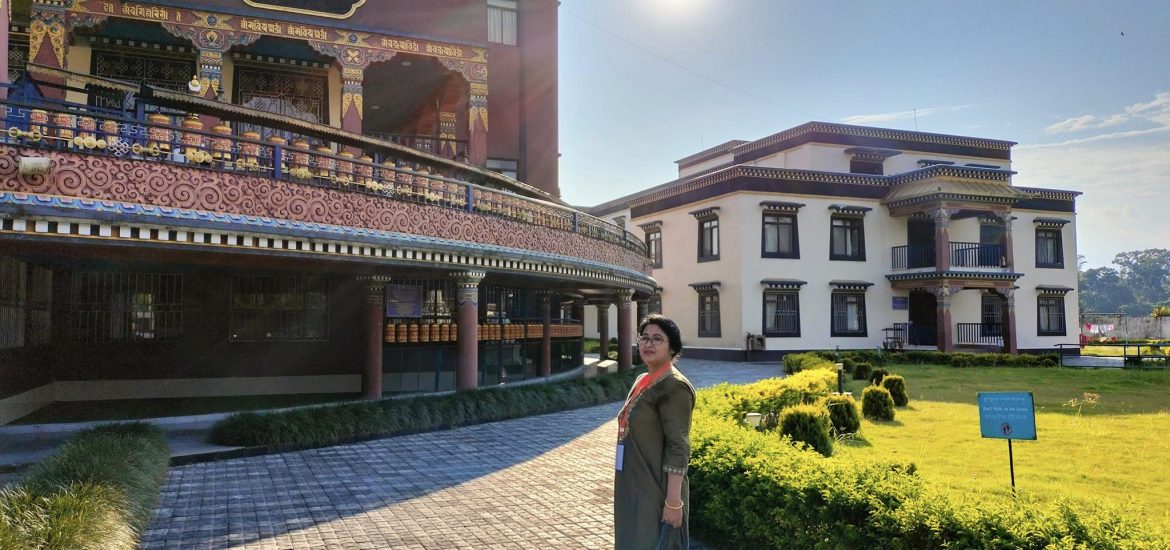Dr. Ramala Sarma is assistant professor in Philosophy at Nowgong College (Autonomous). For years, she has studied the unique socio-cultural dynamics of Buddhism. In this two-part series, she unveils the Buddhist heritage of this lesser-known region of India, which has traditionally been a multicultural area encompassing Himalayan and mainland Indian influences.
BDG: What is the state of Buddhist Studies in Assam? What are the main foci of Buddhist studies in the institutions that you know?
RS: Unfortunately, Buddhist Studies is not included in the curriculum of any institute in Assam. Rather, Buddhism is studied as one of the schools of Indian Philosophy – more specifically, as an elective course in “Religion” under the broad subject “Philosophy.” To my knowledge, Buddhist practices are not incorporated in any of these courses, let alone discussing Buddhism in Assam. Still, some research can be found on various aspects of the Buddhist communities of Assam.
When our college was declared Autonomous in 2020, we were required to present our syllabus. I thought it would be a great opportunity for the students to have some idea about Buddhism in Assam and understand the doctrines of Buddhism in the context of its practice in this region. I proceeded to include the topic in the course of Buddhist Philosophy.
BDG: Tell me a little about your experience of contemporary Buddhism in Assam. Who mainly practices in the region?
RS: I’ll have to go back to the year 2008 when I was awarded my doctorate, and was thinking of taking up Buddhism as my next research area. I had an interest in Buddhism since my student days, which grew stronger when I studied Buddhist nominalism for my PhD, particularly the theory of apohavāda.
As I started studying Buddhism deeply, I saw it was more than simply a philosophy. It was a faith that grew out of Prince Siddhartha’s disquiet with human suffering. It can never be restricted to mere metaphysical and epistemological principles. I realized that this faith or school of thought could better be understood as applied in real life.
I began to look at real-life issues from the Buddhist perspective, wrote about them, and got published in different media. In the meantime, I had been meeting with self-professed Buddhist people in the area even though I did not have much idea about the Buddhist populace. I eventually set off to list the ethnic communities that practice Buddhism in Assam, along with the villages they are located in.
In Assam, the tribes of the Tāi Phāke, Tāi Khāmti, Tāi Khāmyāng, Tāi Turung, and Tāi Āiton (branches of the Tāi), Singpho, Mānn, Tāngsā, Barua, Chākmā, and Tamang practice Buddhism. Except for the Tamang, all are Therāvāda followers. They live in middle and upper Assam, and the eastern part of Arunachal Pradesh, India. I decided to do my formal research on the Tāi communities. I do not remember now what inspired me to study them. Whatever the reason, my decision was right because by working on them, I got to learn about the Buddhist practices of other Buddhist communities like the Singpho, the Tāngsā, and the Mānn. The Mānn practice Buddhism in a similar way as that of the Tāis.
I proposed to the University Grants Commission (UGC) a Minor Research Project called Buddhist Practice of the Tai Communities of Assam. They accepted and later offered financial assistance for carrying out the research. This research eventually led me to write a book titled, Buddhism in Tai Life of Assam (2022) and obtain a Certificate of Registration of Design from the Patent Office of Kolkata in 2020.
You might wonder why I needed a design patent. My intention in innovating this new product is to make the Buddhist teachings accessible to lay Buddhists through a usable item. Styled after a Assamese gamoocha (a famous kind of towel or body wipe), my product is connected to Tāi material culture: specifically, how the Tāi have traditionally displayed hallowed Buddhist symbols and imagery on textiles and fabrics. In addition, I am recording on video two songs in the Assamese style: specifically, caryāgit 1 and 32 with the help of composer duo Grahadhish Sarma and Rajib Chetri. I am hoping to take Buddhist ideas to the masses through music while reviving the almost lost popularity of Caryāgit.
Like their Buddhist counterparts, Buddhists in Assam abide by the precepts and observe religious rituals throughout the year across the world. However, over and above these, the Tāi, Singpho, Mānn, and Tāngsa celebrate some cultural-religious festivals like the māico-chumphāi. They erect and burn a meji (high-raised bamboo-straw makeshift hut) during this festival. The same ritual is also observed during Bhogāli Bihu by mainstream Assamese. From this and many other culturally mainstream ceremonies that have adopted as their own, they may be said to follow the Buddhist Middle Path of “Buddhist by faith and Assamese by culture.”
Working on the faith of a group of communities is harder than I thought and more rewarding than I could have ever imagined. Indeed, I enjoyed the bittersweet experiences I had during my work. I have been impressed by their assimilation with the mainstream Assamese, while their names for events, not to mention the variations in names even within the same community, at times puzzled me. Here I would like to pay a humble tribute to Gyanowada Bhikkhu, the abbot of Margherita Buddha Vihara, who helped me in distinguishing between these variations.


